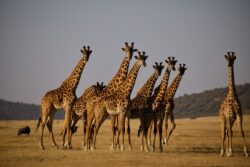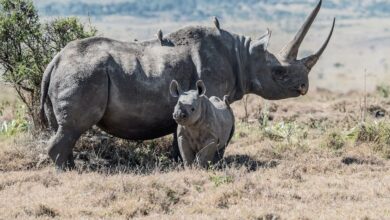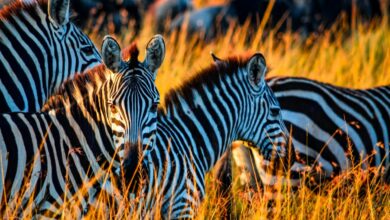9 Questions About Giraffes
How do giraffes reach high trees?
Giraffes are known for their unique and distinctive appearance. They are the tallest land animal, with an average height of between 14 to 18 feet. Their long necks, slender legs, and spotted coats make them instantly recognizable. Their anatomy has evolved over time to help them reach the highest leaves on trees.
Their long necks are created by an elongation of their cervical vertebrae, which consists of 7 bones, just like humans, but each bone is elongated so their necks can extend up to 6 feet long. Additionally, they have a powerful cardiovascular system that pumps blood to their brains even when they are bent over to reach for food.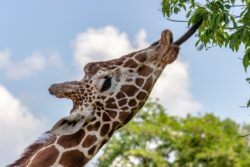
To aid in their unique feeding behavior, giraffes have prehensile lips and long, agile tongues. They can use their prehensile lips to pluck leaves from the trees while their long tongues wrap around branches to pull food into their mouths.
Moreover, giraffes have unique and specialized feet to support their massive frame. They have two toes on each foot with a tough and flexible pad to cushion their steps and prevent slipping on wet surfaces.
Overall, giraffes’ physical appearance and anatomy have evolved to support their ability to reach high trees and feed on vegetation that others cannot.
How do giraffes behave socially?
Giraffes are fascinating creatures, and their behavior in social settings is no exception. Despite their height, giraffes are social animals and live in loose groups known as towers or herds. These groups can have anywhere from 2 to 20 individuals, though sometimes they can also be solitary.
Giraffes have a hierarchical social structure, with males fighting with their necks to establish dominance. Once their hierarchy is established, they tend to be peaceful animals. In fact, giraffes rarely engage in physical altercations, and when they do, they simply use their long necks to deliver a powerful blow.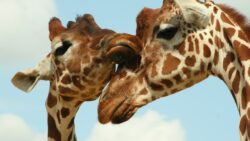
Giraffes also engage in social grooming, in which they use their long tongues to clean each other’s ears and faces. This helps to strengthen social bonds within the group and maintain a healthy social structure.
Interestingly, giraffes also have unique vocalizations that they use to communicate with one another. They make a variety of sounds, from grunts and moans to snorts and bellows, and researchers believe that these sounds play a crucial role in their social interactions.
What do giraffes eat, and where in arid environments?
Their diet mainly consists of leaves, twigs, fruits, and flowers from trees and shrubs, which they can reach using their long necks and tongues that can be up to 45cm long. Surprisingly, giraffes only need to drink water once every few days since they get most of their hydration from the leaves they eat.
To find food sources in arid environments, giraffes have developed an amazing sense of smell and eyesight, which allows them to locate food from afar. They usually roam around in small groups, scanning the trees with their keen sense of sight to spot any vegetation within their reach. When food is scarce, giraffes have the ability to browse on treetops that are up to 5 meters high.
However, despite their ability to adapt to arid environments, giraffes are facing significant threats due to habitat loss, human encroachment, and poaching. Their survival is crucial to maintaining the balance of the savannas they inhabit, making conservation efforts essential to protect these amazing creatures.
What predators do giraffes face, and how do they defend themselves?
In the wild, giraffes face a number of threats from predators such as lions, hyenas, and crocodiles.
When it comes to defending themselves, giraffes have a few tricks up their sleeve. First of all, they are incredibly fast runners, which can help them outrun predators if they need to. They can also use their long legs to deliver powerful kicks, which can be lethal to many predators.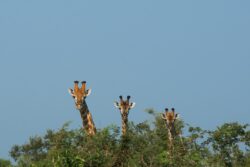
In addition to physical defense, giraffes also rely on their keen eyesight and excellent hearing to detect the presence of predators. They can spot a threat from far away and will often stay close to other giraffes or herd animals for safety in numbers.
While giraffes may face threats from a number of predators in the wild, they have evolved many ways to protect themselves and increase their chances of survival.
What is the giraffe lifecycle & reproductive mechanism?
The gestation period of a giraffe is around 14 months, and once born, the calf weighs around 100-150 pounds and stands six feet tall. The mother gives birth standing up, and within hours, the calf can stand and move around unassisted.
During the first year, the calf will nurse from its mother and gradually transition to eating leaves and vegetation. As the calf grows, it will also begin to play and interact with other young giraffes. At around three to four years old, the giraffe will reach sexual maturity, and a male will be able to mate with a female.
Reproduction in giraffes occurs through sexual intercourse, where the male will get close to the female, and after they mate, fertilization will take place. Once pregnant, the mother will carry the calf for around 14 months and will give birth to the calf in a standing position again.
Once the giraffe reaches adulthood, which is around six years old, it will continue to grow and develop until they reach its full height, which is usually around 18 feet tall for males and 16 feet tall for females. Throughout their lifespan, giraffes will continue to mate, give birth, and play an essential role in the ecosystem they live in.
How do giraffes communicate and what does it tell us about their behavior?
They make soft, low-pitched sounds that are difficult to hear from a distance. These sounds are thought to be used to establish social relationships or to communicate mood or intentions. Sometimes, they make loud snorting or hissing sounds that are used to issue warnings or threats.
In addition to their vocalizations, giraffes also use their body language to communicate with each other. For example, when a giraffe stretches out its neck and lowers its head, it’s a sign of submission. On the other hand, when a giraffe holds its head high and puffs out its chest, it’s a sign of dominance.
Their body language can also tell us about their behavior. For example, when a giraffe is alarmed or scared, it will stand stiffly and stare intently at the source of its fear. If a giraffe is curious, it will often cock its head to one side and twitch its ears.
What is the history and cultural representation of giraffes in art and literature?
Giraffes have long captured the human imagination and played an important role in cultures around the world. The historical and cultural significance of giraffes can be traced back to Ancient Egypt, where depictions of giraffes can be found in hieroglyphics and art. In addition to being a symbol of grace and beauty, giraffes were also considered sacred animals due to their unique physical appearance.
In the Middle Ages, giraffes became highly sought-after exotic animals among European royalty, leading to their depiction in art created for the wealthy and powerful. As interest in natural history grew, giraffes became popular subjects for scientific explorers and illustrators, leading to a more accurate understanding of their anatomy and behavior.
In modern times, giraffes continue to be an important cultural symbol. They have been featured in literature, film, and popular culture. Giraffes are often portrayed as gentle and graceful animals, representing the beauty and wonder of the natural world.
What are the conservation status and threats of giraffes?
The current conservation status of giraffes is ‘vulnerable’ on the IUCN Red List, which means they are at high risk of extinction in the wild if their population continues to decline.
The population of giraffes has decreased by 30% in the past 30 years, with only approximately 111,000 individuals remaining in the wild. The primary threat to giraffes in the wild is habitat loss due to human activity, such as deforestation, agriculture, and infrastructure development.
As giraffes require large areas of suitable habitat, the fragmentation of their habitat by human encroachment poses a significant threat to their survival.
Moreover, poaching, disease, and climate change are other threats that giraffes face in the wild. Giraffes are hunted for their meat, hide, and tail hair. They are also vulnerable to diseases such as rinderpest, which is highly contagious and can wipe out entire populations.
Climate change is causing changes in vegetation, reducing food availability for giraffes, which can impact their survival.
Conservation measures are necessary to save giraffes from extinction. These include habitat conservation, anti-poaching efforts, disease management, proactive breeding programs, and public awareness campaigns.
Raising awareness about the importance of conservation and the threats that giraffes face is critical in protecting these majestic creatures for future generations.
How are giraffes important in the African savannah ecosystem?
Giraffes are integral to the biodiversity of the African savannah. As herbivores, they help to regulate plant growth and contribute to seed dispersal by consuming vegetation and then defecating in different areas.
They also play a crucial role in supporting the food web by providing a source of food for predators like lions and hyenas. Giraffes also help to maintain tree diversity by selectively browsing on leaves from different trees, which allows for the growth of other plant species in the area.
Additionally, their long necks enable them to reach higher branches, which other herbivores cannot access. This prevents competition for food resources among different species and allows for a balance in the ecosystem. Their dung is also rich in nutrients, which provide fertilization for the soil and promote the growth of various plant species.

